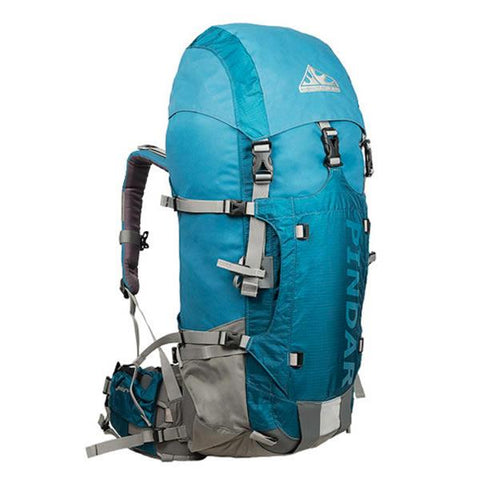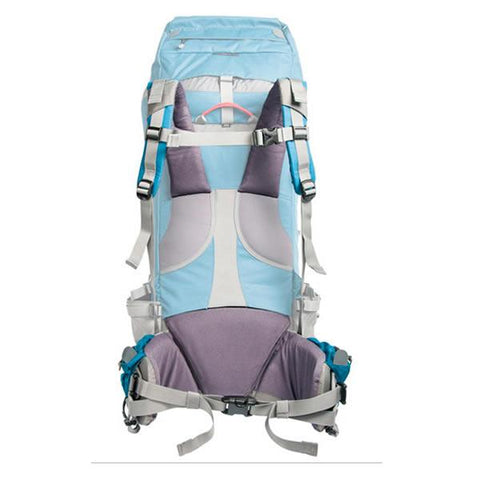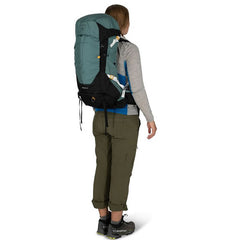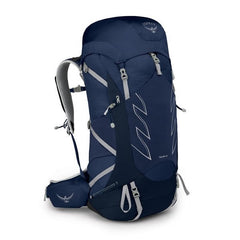Wilderness Equipment Pindar 60 Litre Top Loading Canvas Hiking Backpack - Ocean, Size: Large
Wilderness Equipment
Wilderness Equipment's new mid-volume hiking pack is constructed out of the same high-grade AUSTRALIAN CANVAS as their legendary Lost World pack. Fully featured with dual fold-flat bottle pockets, hydration sleeve and trekking pole mounts this is their most user friendly canvas pack yet. The revolutionary Convert T-PIN harness system allows the hip wings to be rapidly detached, no tools needed, making this a perfect pack for use above and below the snow line.
Pindar 60 Hiking Pack from Wilderness Equipment on Vimeo.
Features and Specifications
- Single-compartment, mid-volume, canvas backpack
- Dual, fold-flat bottle pockets securely hold any size water bottle
- Internal hydration sleeve
- Versatile, back overload pouch expands out to 10 litres extra carrying capacity
- Bag Fabric: High-density 8.8oz genuine corespun canvas
- Reinforcing Layers: 330d nylon Kodra, PU-coated
- Colour: Ocean/Grey
- Internal Frame System: Convert T-Pin frame sheet with high-tensile aluminium spine bar and shoulder-level inverted-U tubular frame
- Shoulder Harness: 640d tough, soft spun polyester
- Hip Harness: Synchro-FORM CONVERT with 3-D multi-laminated pads
- Harness Face Fabric: 640d tough, soft spun polyester
- Back sizes: S/M (400/450mm), L (500mm)
- Bag Capacities: S/M:55, L:60 Litres
- Pack Weights: S/M: 2.86, L: 2.92 kg
Wilderness Equipment Syncro-Form Harness System
Go back to 2003. To improve on the comfort of the long-serving Perfect-Fit harness system was quite a challenge but one we rose to with enthusiasm and cunning. We had carried the idea of an independent hip harness system over many miles of back country travel. With 'thinking time' over, the introduction of our new, independent-wing, Synchro-FORM hip harness was a true advance in backpack comfort. For the first time in a backpack harness system, perfect load-transfer and control was combined with true, resistance-free dynamic freedom, automatic conformance to the wearer's hip contours, a simple adjustment sequence and readily interchanged and maintained components - an extraordinary mix of features, some previously considered to be in conflict.
Since 2013 and continuing in 2014 WE have been making significant refinements to the harness or 'back' systems on many WE pack models. For the new mid-volume models, such as the Haute Route and Pindar 60,WE have developed model-specific variants of our firmly established and renowned big-load Synchro-FORM harness system. Irrespective of the advanced design details of these new harness components the theory behind WE Synchro-FORM independent suspension holds true across all versions...
Synchro-FORM At The HIP LEVEL
The structural base of the hip harness is a pair of pivoting hip-PLATES fixed by direct mechanical means into one of WE's internal frame systems. Then, a range of both 3-D contoured and thin hip-PADS, in a spread of lengths and choice of body face fabrics fit firmly over these plates. The shape and geometry of all these components in the system have been carefully determined. Big-volume packs are fitted with the Hi-LOAD plates and pads. These have a greater body contact area and thicker padding. Daypacks and packs under 60 litre capacity are usually fitted with the slimline EXPRESS components. Body face fabrics are chosen according to likely application. Bushwalking models use WE's high-tech canvas for comfort and durability, alpine models use a tough, textured polyester fabric for snow shedding and minimal water absorption, travel and urban use models usually use a soft, comfortable airmesh. The Hi-Load THIN pad construction requires the use of a 1000d textured nylon stretch fabric, the only choice. The hip-PLATES themselves incorporate thin padding and a textured polyester face. If minimalist design is your thing, or you need to free up space for a climbing harness, try using a WE pack with just the hip plates, pads removed. The Synchro-FORM system's built-in dynamic freedom displaces the need for thick padding unless your load is substantial or you could describe your build as 'skin on bone'.
Where to Best Load the Hips?
The hip-PAD shape is such that the bulk of the surface area bears directly over the well cushioned upper surfaces of the gluteus maximus (backside) muscles. This positioning is important. It's a bad idea to somehow project the load distribution too far forward around the hips, even though you see some brands making a fuss about this and incorporating struts that terminate forward on the hip harness wings . One important reason not to is that it increases the reaction force needed at shoulder level to prevent the pack falling backwards and this can get quite uncomfortable. To understand this, stand right on the edge of a step using only your toes and the very front of your feet. You can immediately feel the backward pull of your body weight and must oppose it by holding a railing or leaning forward. Another bad effect of trying to transfer pack load to the side of the hips is that it interferes directly with the simple body dynamics of walking, not to mention climbing. As each hip rises you must also lift the pack weight it is loaded with. In summary, the upper-surface of the gluteus maximus muscles is where most load should be carried. Direct pressure on the central lumber spine is avoided by leaving a narrow space between the independent hip pads. On some models, mainly for aesthetic reasons, WE provide a thinly padded lumbar flap that fastens up over this gap. It can also be tucked behind (or permanently removed by cutting the Hypalon bridge).
How does it all work?
When you close and tighten the hip harness straps, the hip plates, with their pads, automatically rotate to conform exactly to your individual hip shape. The plates also ensure that pressure from your pack load is spread out as evenly as possible on the hip pads by preventing their edges curling back around the webbing tension lines. As you walk, scramble, climb, ski or ride the hip plates individually track your hip motion in a way that no other system can. Touch the hip plates as you walk along. Even with this gentle motion you can feel the extent of the movement! The thing is that this freedom is provided without any compromise to load transfer or precise control. Magic! Notice how the main buckle straps double back through rectangular metal loops. These act as pulleys so you can effectively tighten your harness by pulling the strap ends forward, an easier action made even easier by the 2:1 advantage the metal loop pulleys provide. Finally, side stabiliser straps are provided and allow a final tweek to the system's already excellent, built-in torsional control of the lower pack bag.
Extra-Heavy Loads
Extra-heavy load carrying causes all harnesses to want to sink lower on your hips. The Synchro-FORM hip system incorporates a simple LINK STRAP which can be plugged in to connect the bottom edges of the hip plates lobes. The length of this strap fixes the contour of the harness by limiting upward rotation - longer for more conical, typically female hips, shorter for more cylindrical, typically male hips. With a link strap in place the hip wings still retain the freedom to 'see-saw' with hip motion. Think of the link straps as anti-roll bars on otherwise completely independent hip suspension. With heavy, expedition size loads they help to offset the hip strap tension otherwise needed to optimise load pressure distribution around the hips.
Trimmed for Travel
A nice spin-off of the independent hip pad design is that, harness cover or not, by releasing the side stabiliser straps to their limit, tucking the lumbar cover flap behind (and disconnecting one side of the link strap if you use it) the hip wings can be rotated upwards to lie vertically along the pack harness panel. If you then fasten the hip closure buckle around the top carry handle and cinch in the shoulder harness straps, the pack is ready for a baggage system. No projecting parts. Double magic!
Synchro-FORM at the SHOULDER LEVEL
WE's Synchro-FORM shoulder harness also features some nice, unique, solutions. Like the hip pads, WE's shoulder harness arms are now 3-D, with pre-curved side walls where they curve over the shoulders. The fabric used on the body contact face is the same as that used on the hip-PADS. Don't underestimate the amount of work in making these sophisticated components in durable fabrics. Yet, put on a new WE pack, and the benefits are immediately clear.
Shoulder Harness Curvature
Shoulder harness comfort depends on even contact and pressure distribution over the upper surface of the shoulders. With the wide variation in human shoulder surface contours - due mainly to the level of trapezius muscle development - no one fixed-shape harness can rest evenly on them all. Providing the shoulder harness arms with some pivot freedom where they depart from the harness panel is only a partial solution. At the front of the body the shoulder harness must eventually follow the line of the adjustment strap connecting it to the pack base. Steeply falling shoulders require more curved harnesses or pressure will concentrate inside against the neck. The pain increases as the day wears on. Flatter, more level shoulders need straighter harnesses.
Previously WE solved this problem by offering several curvatures of interchangeable shoulder harnesses. With the new system the solution is as simple and effective as it is novel. The region of the shoulder harness shell fabrics that lie over the top of the shoulders (body face, top face and crescent side walls) are all cut on the fabric diagonal or bias. This allows them to shear or distort to different shapes when forced. To effect this change of shape we have developed a series of stiff, curved plates that slip into closely fitting pockets on the upper surface of the shoulder harness arms. The plates are designated '10', '20' and '30' to correspond to shoulder slopes of roughly 10 degrees, 20 degrees and 30 degrees. The undistorted harness shape conforms well to a 20 degree shoulder slope and the 20 plate is fitted at assembly. Back-country pack models that are likely to see high loads are supplied with 10 and 30 plates packed in the top/camera pocket. For users of other packs these plates can be supplied at request. Use a pair of GP pliers to assist in changing shoulder insert plates. We were probably the first pack brand in the world to use high-density plastic plates on WE's hip harness wings to prevent edge curl of the padding (in 1980). Now at the shoulder level WE's insert plates also perform this additional function. You will not find a more sophisticated or comfortable shoulder harness anywhere.
The Harness Panel
The shoulder harness arms emerge from the harness panel through simple guide sleeves which provide complete lateral stability. The harness arms are joined by a contoured fabric bridge which prevents the padded arms leaving the guide sleeves. Extension and retraction of the shoulder harness is done at the 3-bar slide at the base of the harness panel, usually hidden by the lumbar flap. Both Quick and Comprehensive pack fitting instructions are provided on the separate webpage Using Your WE Backpack. Read these to get the most from any backpack. Since you may be trying a WE pack on with a view to purchase please note that our top stabiliser straps and the main shoulder harness adjustment straps use a thicker webbing which prevents them creeping out of adjustment in use. Adjustment requires more than a simple pull on the webbing tail. A deliberate action to tilt the adjustment buckle is also needed to allow this webbing to run. That's a small price to pay given you can walk in comfort, hour after hour, without having to make constant adjustments. Finally, the sternum strap is built-in on the shoulder harness and not removable. We have retained the perfect wrap-around capture of the harness arms and vertical adjustment is simple.
Size Changes - Mix and Match
All pack models are fitted with medium size Synchro-FORM hip system components and shoulder harnesses of a size corresponding to the pack back length. Longer hip-PADS mount directly on the standard medium hip-PLATES, small hip-PADS - for extremely narrow waists - require a change of Hip-PLATE, to small size. Synchro-FORM shoulder harnesses are completely interchangeable but the only change likely to ever be necessary is up a size for a longer span, usually to accomodate a particularly heavy build. Packs fitted with the slimline Synchro-FORM Express hip system can be retro-fitted with Hi-Load hip components if super-heavy loads are carried.
Removing and Re-fitting Synchro-FORM Harness Components
Where a daypack is not fitted with a substantial hip harness WE specify the back length so you can judge how it might rest on your back. Some long daypacks may be too long for use on very short torsos.
Where WE quote a back length of 450mm this is the distance from base seam on the harness panel up to either the shoulder harness top stabiliser strap anchor buckles (if present), or otherwise, the seam where the fixed shoulder harness arms attach to the pack bag (as with the classic canvas daypack models). Our daypack back lengths are either 400mm (S), 450mm (M) or 500mm(L).
You can think of these lengths as corresponding to the backpack sizes S, M and L for packs that ARE fitted with substantial hip harness systems. If you are a size L in this type of pack then you will also be able to comfortably carry a 500mm back length basic daypack.
The majority of WE's simple daypack models are 450mm, suitable for all but the shortest torsos.
Steps to Measuring Your Back Length
Measure the vertical distance from the crest of your hip bone up to the level of your shoulder surface, where the pack shoulder harness will rest. Find the top of your hip bone (pelvic crest) on one side. Hold the end of a tape measure on the bone. It slopes down as you move along it towards the front centreline of your body. Find a position directly down from a point on the corresponding shoulder at the place where the shoulder harness arm will cross it. Now, extend the tape measure vertically upwards from the hip bone and, at the same time, rest a ruler or other straight edge horizontally on your shoulder, extending forward from where the shoudler harness padded arm will rest. Ask someone to help out with this. Read off and note the distance where the shoulder level meets the tape measure.
Back Lengths and Pack Sizes Wilderness Equipment
| Measurement | WE Pack Size |
| Up to 35 cm | Extra Small |
| 35 cm to 40 cm | Small |
| 40 cm to 45 cm | Medium |
| over 45 cm | Large |













STAY IN TOUCH